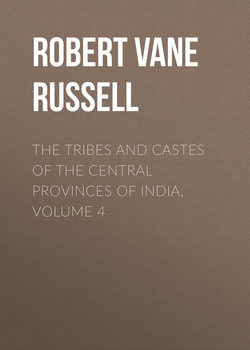Читать книгу The Tribes and Castes of the Central Provinces of India, Volume 4 - Robert Vane Russell - Страница 97
Part II
Articles on Castes and Tribes
Kumhār—Yemkala
Vol. IV
Lodhi
2. Position in the central Provinces
ОглавлениеIn the Central Provinces they have become landholders and are addressed by the honorific title of Thākur, ranking with the higher cultivating castes. Several Lodhi landholders in Damoh and Saugor formerly held a quasi-independent position under the Muhammadans, and subsequently acknowledged the Raja of Panna as their suzerain, who conferred on some families the titles of Rāja and Diwān. They kept up a certain amount of state, and small contingents of soldiery, attended by whom they went to pay their respects to the representative of the ruling power. “It would be difficult,” says Grant,93 “to recognise the descendants of the peaceful cultivators of northern India in the strangely accoutred Rājas who support their style and title by a score of ragged matchlock-men and a ruined mud fort on a hill-side.” Sir B. Fuller’s Damoh Settlement Report says of them: “A considerable number of villages had been for long time past in the possession of certain important families, who held them by prescription or by a grant from the ruling power, on a right which approximated as nearly to the English idea of proprietorship as native custom permitted. The most prominent of these families were of the Lodhi caste. They have developed tastes for sport and freebooting and have become decidedly the most troublesome item in the population. During the Mutiny the Lodhis as a class were openly disaffected, and one of their proprietors, the Tālukdār of Hindoria, marched on the District headquarters and looted the treasury.” Similarly the Ramgarh family of Mandla took to arms and lost the large estates till then held by them. On the other hand the village of Imjhira in Narsinghpur belonging to a Lodhi mālguzār was gallantly defended against a band of marauding rebels from Saugor. Sir R. Craddock describes them as follows: “They are men of strong character, but their constant family feuds and love of faction militate against their prosperity. A cluster of Lodhi villages forms a hotbed of strife and the nearest relations are generally divided by bitter animosities. The Revenue Officer who visits them is beset by reckless charges and counter-charges and no communities are less amenable to conciliatory compromises. Agrarian outrages are only too common in some of the Lodhi villages.”94 The high status of the Lodhi caste in the Central Provinces as compared with their position in the country of their origin may be simply explained by the fact that they here became landholders and ruling chiefs.
93
Narsinghpur Settlement Report (1866), p. 28.
94
Nagpur Settlement Report, p. 24.
